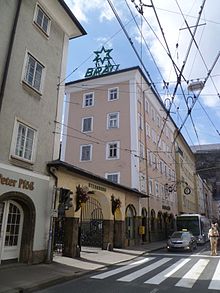Griesgasse (Salzburg)
The Griesgasse (formerly On semolina) is one of the most famous streets of the old town of Salzburg .
About the name and origin of the alley
The name is derived from the coarse Salzach sand , which was called Gries . After a slight bend, the wide Griesgasse in Salzburg runs in a straight line in front of the historic city wall, which runs parallel to the Salzach, between Gstättengasse (or Anton-Neumayr-Platz) towards the extended state bridge and was largely rebuilt in the early 17th century under Prince Archbishop Wolf Dietrich von Raitenau and Paris Lodron created by embankments over the Salzachgries and bank protection on the Salzach. Before that, there was a free, often flooded area with cattle pastures, and at the edge with orchards and vegetable gardens. In the time of the prince-archbishop the street was called Unterer Gries, so the upper Gries was probably south of the main bridge (today Rudolfskai).
The sights of the alley (including Badergäßchen and Münzgasse)
Here, next to the Salzach, was also the old, neatly designed Türnitz, once the oldest barracks building in Europe, which was demolished in the years after 1860 to extract stone material for fortifying the banks of the Salzach. The city pillory stood right next to the old Türnitz.
In 1548 the municipal Brunnhaus (“Prunhaus”) on Gries was opened in Griesgasse (today house no. 37 is located there), which pumped up groundwater using the power of Almkanal water. This municipal well house switched to steam operation after 1800 and was destroyed by American aerial bombs in 1944.
The small waterer in the city fortifications (for the watering of the cattle kept in the city), which led out to the Gries, was called the water, semolina or meat gate.
Today's houses nos. 1, 3, 5 and 7, close to the city bridge, are the result of the expansion of old houses, mostly from the 16th and 17th centuries. House No. 8 bears the inscription of the famous stonemasonry Johann Doppler in the lintel . An old defensive tower of the city wall is hidden in house number 11 with its two-story bay window. The Kronenhaus (No. 15) was once a home for the poor and old people. The house no. 21 was the "common town Schmiede" (smith house of the municipality).
There is a small museum of traditional costumes in the house at Griesgasse 26.
The slaughterhouses
The butcher's banks, where the animals were also slaughtered, were located on the main bridge of the city before 1607 and have been there since the 14th century. ( Such a bridge with merchants 'shops can still be found today in Italy, in stately size and made of stone - for example on the so-called Ponte Vecchio in Florence or on the Rialto Bridge in Venice.) Under Archbishop Wolf Dietrich von Raitenau , the butchers' banks were used in 1607 to relieve those at that time The bridge with little load-bearing capacity was relocated to the location at Gries (Griesgasse). The space on the main artery was also extremely limited. Wolf Dietrich had 12 meat banks built on Gries and 3 others made of wood, with each butcher receiving its own well. The meat banks consisted of a slaughterhouse and a spatially separated filing bank (shop). The sales benches ranged from the main bridge (today's Staatsbrücke) to Gstättengasse. A plaque with a reference to the butchers' guild and a replica of the butcher's coat of arms in the courtyard of house no. 19, where one of the slaughterhouses was located, still indicate its former importance. In 1816 the slaughterhouses were relocated to the Rösslstadel of the Mödlhammerwirt in Lehen after there was no room for such a slaughterhouse in the Griesgasse area. There, the earlier slaughterhouses were organized as a single slaughterhouse for the first time.
The fish market
The fish market was in the area of today's fish shop "Fisch-Krieg". The Wilde-Mann-Brunnen was also located here as a Fischkalter, which is now reduced in size at the Wilhelm-Furtwängler-Garten (where the fish market took place from 1872–1926). The fountain figure of the Wild Man (Aquarius) with the city coat of arms reminds of the former purpose. The fish caught on the Salzach and the surrounding lakes and rivers were sold here. The sales stands of the Liefering fishermen were particularly numerous.
The Griesbad
In house Griesgasse no. 7 a bathing room, the "Griespat" (Griesbad) has been known since the Middle Ages. Mentioned in a document as early as the 14th century, the bath next to the Salzach is probably much older. It lasted into the early 20th century. In 1752 this bath included:
- a shaving room
- a laboratory (partly comparable to a doctor's office)
- a bath room with an adjacent vault
- a layer of wood for the required firewood
- a coal manger
- a horse stable on the ground floor
- a herb chamber under the roof
- a material chamber
In the time of the prince-archbishop there was another bath nearby, the souls or poor baths. (see article Getreidegasse ).
The city forge
The town forge was located in Griesgasse 21 until around 1935, and its history as a locksmith's shop dates back to the time of the prince-archbishop. Here both wagon parts and wagon wheel parts were forged (wagon smiths) and horses were shod (blacksmiths).
The Münzgasse
Münzgasse was only built in 1953 on the site of bombed-out houses. The prince-archbishop's mint once stood here.
literature
- Georg Dehio (greetings), Bernd Euler, Ronald Gobiet u. a. (Arrangement): Salzburg. City and Country ( The Art Monuments of Austria ). Schroll Verlag, Vienna 1986, ISBN 3-7031-0599-2 .
- Josef Hübl: Local history of the city of Salzburg . Verlag Salzburger Druckerei, Salzburg 1965.
Coordinates: 47 ° 48 ′ 2.9 ″ N , 13 ° 2 ′ 28.2 ″ E

